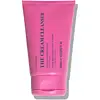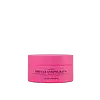What's inside
What's inside
 Key Ingredients
Key Ingredients

 Benefits
Benefits

 Concerns
Concerns

 Ingredients Side-by-side
Ingredients Side-by-side

Water
Skin ConditioningCaprylic/Capric Triglyceride
MaskingSimmondsia Chinensis Seed Oil
EmollientSqualane
EmollientPropanediol
SolventGlycerin
HumectantGlyceryl Stearate
EmollientPEG-100 Stearate
Cetearyl Alcohol
EmollientPhenoxyethanol
PreservativeJojoba Oil/Macadamia Seed Oil Esters
Skin ConditioningBetaine
HumectantCarbomer
Emulsion StabilisingHydroxyacetophenone
Antioxidant1,2-Hexanediol
Skin ConditioningCaprylyl Glycol
EmollientParfum
MaskingSodium PCA
HumectantSodium Hydroxide
BufferingXanthan Gum
EmulsifyingTetrasodium Glutamate Diacetate
Squalene
EmollientEthylhexylglycerin
Skin ConditioningSodium Lactate
BufferingHelianthus Annuus Seed Oil
EmollientPCA
HumectantCitric Acid
BufferingBiosaccharide Gum-1
HumectantSerine
MaskingAlanine
MaskingPhytosteryl Macadamiate
Skin ConditioningGlycine
BufferingGlutamic Acid
HumectantRosmarinus Officinalis Leaf Extract
AntimicrobialGlycine Hcl
BufferingThreonine
Arginine
MaskingPhytosterols
Skin ConditioningTocopherol
AntioxidantProline
Skin ConditioningTrisodium EDTA
Water, Caprylic/Capric Triglyceride, Simmondsia Chinensis Seed Oil, Squalane, Propanediol, Glycerin, Glyceryl Stearate, PEG-100 Stearate, Cetearyl Alcohol, Phenoxyethanol, Jojoba Oil/Macadamia Seed Oil Esters, Betaine, Carbomer, Hydroxyacetophenone, 1,2-Hexanediol, Caprylyl Glycol, Parfum, Sodium PCA, Sodium Hydroxide, Xanthan Gum, Tetrasodium Glutamate Diacetate, Squalene, Ethylhexylglycerin, Sodium Lactate, Helianthus Annuus Seed Oil, PCA, Citric Acid, Biosaccharide Gum-1, Serine, Alanine, Phytosteryl Macadamiate, Glycine, Glutamic Acid, Rosmarinus Officinalis Leaf Extract, Glycine Hcl, Threonine, Arginine, Phytosterols, Tocopherol, Proline, Trisodium EDTA
Cetearyl Ethylhexanoate
EmollientPEG-20 Glyceryl Triisostearate
EmollientEthylhexyl Palmitate
EmollientPrunus Amygdalus Dulcis Oil
Skin ConditioningJojoba Esters
EmollientSucrose Tetrastearate Triacetate
EmollientSorbeth-30 Tetraoleate
EmulsifyingHelianthus Annuus Seed Wax
Skin ConditioningSimmondsia Chinensis Seed Oil
EmollientSqualane
EmollientCanola Oil
EmollientTocopherol
AntioxidantJojoba Oil/Macadamia Seed Oil Esters
Skin ConditioningAcacia Decurrens Flower Wax
EmollientPolyglycerin-3
HumectantSqualene
EmollientHelianthus Annuus Seed Oil
EmollientDaucus Carota Sativa Seed Oil
EmollientDaucus Carota Sativa Root Extract
Skin ConditioningPhytosteryl Macadamiate
Skin ConditioningBeta-Carotene
Skin ConditioningTocopheryl Acetate
AntioxidantPhytosterols
Skin ConditioningPhenoxyethanol
PreservativeEthylhexylglycerin
Skin ConditioningCetearyl Ethylhexanoate, PEG-20 Glyceryl Triisostearate, Ethylhexyl Palmitate, Prunus Amygdalus Dulcis Oil, Jojoba Esters, Sucrose Tetrastearate Triacetate, Sorbeth-30 Tetraoleate, Helianthus Annuus Seed Wax, Simmondsia Chinensis Seed Oil, Squalane, Canola Oil, Tocopherol, Jojoba Oil/Macadamia Seed Oil Esters, Acacia Decurrens Flower Wax, Polyglycerin-3, Squalene, Helianthus Annuus Seed Oil, Daucus Carota Sativa Seed Oil, Daucus Carota Sativa Root Extract, Phytosteryl Macadamiate, Beta-Carotene, Tocopheryl Acetate, Phytosterols, Phenoxyethanol, Ethylhexylglycerin
 Reviews
Reviews

Ingredients Explained
These ingredients are found in both products.
Ingredients higher up in an ingredient list are typically present in a larger amount.
Ethylhexylglycerin (we can't pronounce this either) is commonly used as a preservative and skin softener. It is derived from glyceryl.
You might see Ethylhexylglycerin often paired with other preservatives such as phenoxyethanol. Ethylhexylglycerin has been found to increase the effectiveness of these other preservatives.
Helianthus Annuus Seed Oil is the oil derived from the seeds of a Sunflower. Sunflower seed oil is non-fragrant. It is an emollient, meaning it helps to soften the skin.
Sunflower seed oil contains many fatty acids. The fatty acids found in sunflower seeds include (from highest amount to least): linoleic acid, myristic acid, palmitic acid, stearic acid, arachidic acid, oleic acid, and linolenic acid.
These fatty acids help the skin create ceramides. Ceramides play a role in repairing the skin barrier.
Helianthus Annuus Seed Oil helps moisturize the skin. This in turn helps the skin look more rejuvenated and smoother.
Sunflowers are rich in vitamin E.
Historians believe Indigenous cultures of North America domesticated sunflowers before corn. Thus they relied on sunflower oil for a variety of uses. One such use is moisturizing skin and hair.
Sunflower seed oil may not be fungal acne safe. We recommend speaking with a professional if you have any concerns.
Learn more about Helianthus Annuus Seed OilThis ingredient is a mixture of jojoba oil and macadamia seed esters.
The cool thing about this ingredient is that it is part of L22, a patented lipid compound designed to mimic a young adult's skin surface lipid profile.
Because this ingredient mimics the natural oils in your skin, it helps keep your barrier healthy and hydrated.
The manufacturer's tests found:
Learn more about Jojoba Oil/Macadamia Seed Oil EstersPhenoxyethanol is a preservative that has germicide, antimicrobial, and aromatic properties. Studies show that phenoxyethanol can prevent microbial growth. By itself, it has a scent that is similar to that of a rose.
It's often used in formulations along with Caprylyl Glycol to preserve the shelf life of products.
Phytosterols come from plants, nuts, and whole grains. These compounds have skin soothing and moisturizing properties.
Fun fact: They are similar to cholesterol and can help lower cholesterol levels.
Phytosteryl Macadamiate comes from the fatty acids of Macadamia Seed Oil and an ester of phytosterol. Phytosterols are the plant-versions of cholesterol.
This ingredient helps provide hydration due to its high fatty acid content.
This oil comes from the seeds of the desert shrub called Jojoba. It is more commonly known as jojoba oil, a non-comedogenic oil.
Jojoba oil does not contain fragrance and has many fatty-acids, making it a great soothing ingredient.
It also contains Vitamin E, a great moisturizing ingredient. Vitamin E is also an antioxidant and protects your skin against oxidative damage.
This ingredient humectant properties, meaning it helps draw moisture from the air. This helps keep your skin hydrated.
While jojoba has antibacterial properties, it is only able to kill some strains of bacteria.
Studies also show it helps in wound healing. In fact, Indigenous cultures have used jojoba as a moisturizer and to help treat burns for centuries.
Fun fact: Jojoba oil similar to natural human skin sebum, so it has a great effect on dry skin. It is also promising with helping to regulate sebum production.
Due to its fatty acid content, Jojoba oil may not be fungal acne safe. We recommend speaking with a professional if you have any concerns.
Learn more about Simmondsia Chinensis Seed OilSqualane is an emollient that helps the skin hold onto moisture. It's an oily liquid that occurs naturally in certain types of fish and plant oils.
Because squalane boosts hydration in the skin, it also comes with plenty of benefits: it is an antioxidant and can help fight free radicals and skin damage. Squalane is also found to have a detoxifying effect when applied.
Squalane comes from squalene, which occurs naturally within the sebum of our skin. It is one of the oils our skin produces to keep itself hydrated. Squalane is the hydrogenated version of squalene and has a longer shelf life.
Research shows that squalane is non-irritating (even at 100% concentration).
In general, it's a fantastic ingredient. It does a great job at hydrating the skin, and it's suitable for those with sensitive skin.
The source of squalane may impact malassezia / fungal acne. This is because olive oil derived squalane can contain impurities such as fatty acids and plant waxes. Sugarcane derived squalane is recommended for anyone with malassezia concerns.
Is squalane vegan?
This depends on the source. Squalane can be derived from both plants and animals. Most squalane used in skincare comes from plants.
Please note: the source of squalane is only known if disclosed by the brand. We recommend reaching out to the brand if you have any questions about their squalane.
Read more about squalene with an "e".
Is squalane an oil?
Squalane is often called an oil, but it’s technically not; it’s a hydrocarbon, meaning it’s only made of carbon and hydrogen, unlike true oils which are triglycerides made of fatty acids and glycerol.
The term “oil-free” isn’t regulated, so companies can define it however they want. Some exclude all oils, while others just avoid mineral oil or comedogenic oils.
While some people avoid oils thinking they cause breakouts, the right kind of oil (or oil-like ingredient like squalane) can actually help balance and hydrate your skin. It’s worth testing out simple oils or squalane to see what works best for your skin.
Learn more about SqualaneSqualene is naturally found in plants and animals, including our skin and sebum. It is a lipid our bodies naturally produce and makes up about 10-12% of the oil on our skin. Our skin produces squalene to keep itself naturally hydrated.
This ingredient is a potent antioxidant and can help fight against skin damage.
Sources of squalene include olives and rice bran. Some sources may be animals such as from shark liver.
Squalane comes from squalene and is created using hydrogenation. Squalane is lighter than squalene.
Hydrogenation is the conversion from unsaturated oil to saturated oil. This makes squalane more stable and have a longer shelf life than squalene.
Read more about squalane with an "a".
Learn more about SqualeneTocopherol (also known as Vitamin E) is a common antioxidant used to help protect the skin from free-radicals and strengthen the skin barrier. It's also fat soluble - this means our skin is great at absorbing it.
Vitamin E also helps keep your natural skin lipids healthy. Your lipid skin barrier naturally consists of lipids, ceramides, and fatty acids. Vitamin E offers extra protection for your skin’s lipid barrier, keeping your skin healthy and nourished.
Another benefit is a bit of UV protection. Vitamin E helps reduce the damage caused by UVB rays. (It should not replace your sunscreen). Combining it with Vitamin C can decrease sunburned cells and hyperpigmentation after UV exposure.
You might have noticed Vitamin E + C often paired together. This is because it is great at stabilizing Vitamin C. Using the two together helps increase the effectiveness of both ingredients.
There are often claims that Vitamin E can reduce/prevent scarring, but these claims haven't been confirmed by scientific research.
Learn more about Tocopherol